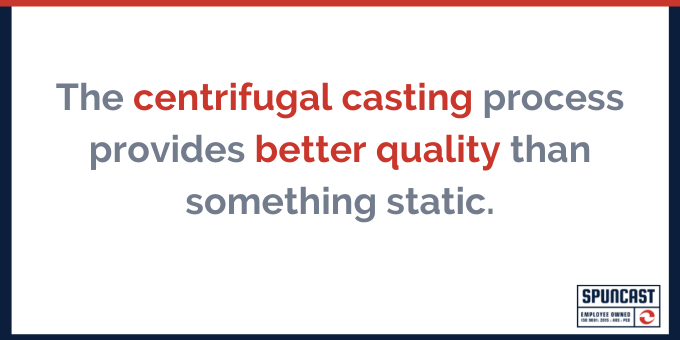Centrifugal casting is a highly efficient manufacturing process for creating hollow cylindrical parts that are economical and offer superior soundness. It’s also a process that is often either unknown or misunderstood.
From the different types available to the varying industry applications, this article will explore the ins and outs of how centrifugal casting works, how your company will benefit from it, and what components it can produce.
Here is a quick video covering what you will read below:
What is centrifugal casting?
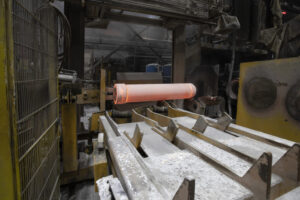
Centrifugal casting involves pouring molten metal into a quickly rotating cylinder-shaped mold. A centrifugal force is created by the rapid rotation, which pushes the metal towards the inside wall, where it cools and solidifies. The result is a fine grain tube that can be machined into various components.
Types of centrifugal casting
There are two types of centrifugal casting processes: vertical and horizontal. Both types rely on a spinning mold creating a centrifugal force to form the desired cast.
The resulting parts are in demand within industries like mining, steel, energy, water treatment, oil and gas, and other sectors requiring hollow, cylindrical forms or components obtainable from such a form.
The casting process is performed using the horizontal method in most cases, explained in further detail below.
How does the centrifugal casting process work?
1. MELT: Metals have a higher melting point than most other materials and reach a molten (liquid) state when exposed to high temperatures. The wall thickness of the metal casting is controlled by the amount of material added during the pouring phase.
2. CAST: Next, the molten metal is poured into a rapidly rotating, cylinder-shaped mold as it slowly starts to cool down. Since large forces press the molten material for the cast part against the mold wall, good surface finish and detail are characteristic of the process.
3. SPIN: The energy produced from the spinning forces the material to conform to the shape of the mold. Impurities, such as metal inclusions and trapped air, collect in the lower density inner regions of cylindrical parts cast by this process.
4. REMOVE: From there, the process exerts pressure that pushes impurities to the center of the axis of rotation. Pure, dense material is left behind once the impurities are machined out of these inner regions.
5. FINISH: The end products produced are unyielding and defect-free and can be machined to suit custom or standard size requests. This method can make substantial metal castings. Many sizes of cylindrical pipes can be manufactured using this technique.
What’s the advantage of centrifugal casting?
While hot extruded tubing, forged tubing, rolled and welded tubing, even tubing machined from bar stock are sometimes used to create tubes, centrifugal casting continually proves to be a reliable and cost-effective solution, easily replacing other methods.
It’s a casting process that is very well suited for the manufacture of hollow cylindrical tubes because the forces used in this method guarantee good adhesion of the casting material to the surface of the mold.
Greg Whitman, Vice President of Sales and Engineering at Spuncast metal foundry, explains that centrifugal casting creates better quality tubes because of its dynamic nature.
“The centrifugal casting process is moving – constantly spinning. That forces the metal into the naturally forming voids that other castings would have. Therefore it’s better quality than something static,” he said.
“In a static or non-moving cast process, there’s nothing dynamic happening. You’re dumping molten metal into a shape, and it comes out solid when it cools off,” he said.
Three good reasons to use centrifugal casting for your metal components
1. It’s a process that creates high production cost-efficiency.
Experienced foundries like Spuncast, which have operated in centrifugal castings for over 45 years, use various raw materials like high and low alloy steels, stainless grades, and duplex metals.
The efficiency of the process and the methods they use reduces defective and, therefore, rejected parts. The material produced is denser and less porous, often allowing up to 90% of the material to be recovered.
Methods like cutting shorter parts to be cast in multiples and then cut to desired lengths is one such practice that has been proven to produce many needed parts, all from a single casting. Intelligent processes like that require less metal and produce less waste creating improved production cost-efficiency.
2. The mechanical properties can have approximately 30% greater strength.
Following through with better foundry practices is essential in every phase of the process to get a better metal part. During the pouring and solidification phase of centrifugal casting, tapping into the forces involved plays a significant role in the superior properties of the castings manufactured.
If done correctly, the outer surface areas will have a higher density than the inner surface areas and result in a seamless, more robust cylinder. Because of the very fine grain outer surface produced in this phase, the mechanical properties can have approximately 30% greater strength than parts formed with static casting methods.
The diagram below from the Library of Manufacturing shows how the forces are more significant the further away they get from the center of rotation.
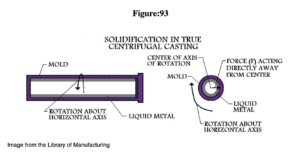
3. A constant centrifugal force pushes out impurities that can be easily removed.
The metal’s density is higher than most of the impurities within the material, which means contaminants like slag, dirt, and drops that have a lower density spin to the core or center. As part of the casting operation, the impurities are removed or machined off later.
The rate of the mold rotation during manufacturing must be carefully calculated to get this desired effect. The spinning speed is determined by considering the mold dimensions and the metal used in the process.
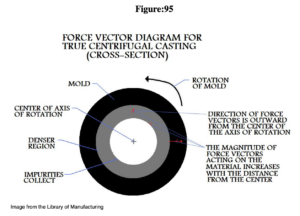
The rapid spin fills any shrinkage voids by creating high pressure and putting the material under a constant centrifugal force.
What are some centrifugal casting applications?
There are numerous applications that benefit from the centrifugal casting method. From roll bodies to centrifuges, the process reliably yields greater part strength, higher product purity, and better cost-effectiveness.
The flexibility of centrifugal casting helps consistently repeat the application advantages. Some of the more specific benefits of each application are listed below.
Roll bodies
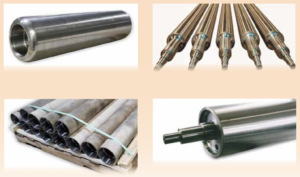
Centrifugal castings are an obvious fit for roll bodies because they are formed round, concentric, and free from mid-wall voids. Centrifugal force assures uniform wall thickness and extremely close concentricity that can be further enhanced by surface machining.
Advantage: Prevents deformations and weak points in roll bodies
Industry Applications: Steel Mills, Glass Mills, Roller Hearth Furnaces, Any Application Requiring Balance and Performance
Pump & valve components
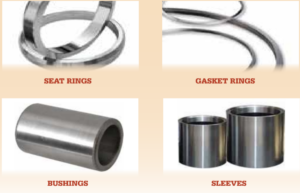
All steel alloys and tubular geometry makes centrifugal casting a natural fit for pump and valve applications. With machining, designs can be taken from raw stock to finish and ready for assembly.
It’s an excellent solution for OEM pump and valve manufacturers looking for replacements as well as custom designs and aftermarket replacement parts.
Advantage: Creates consistent, superior strength steel pump and valve components
Industry Applications Mining, Infrastructure and Building Control, Cooling Systems and Heat Transfer, Defense, Fire Prevention, Fluid Handling, and Chemical Storage, Food and Beverage, Water Treatment, Power Generation, and more
Hydraulic cylinders
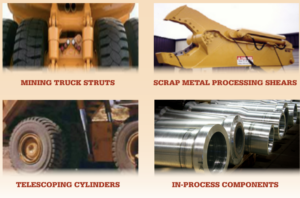
Hydraulic systems must work under severe pressures, which means increasing individual component design details becomes more important and costly.
Because the centrifugal casting manufacturing operation produces metal cast parts without the need for sprues, risers, or other gating system elements like forging uses, it’s a very efficient industrial process that saves production costs while still producing solid components.
Advantages: Offers a cost-saving alternative to forging for hydraulic cylinders
Industry Applications: Mining, Scrap Metal Processing, Industrial Presses, and In-Process Components, OEM Replacements, Aftermarket Repair
Centrifuges
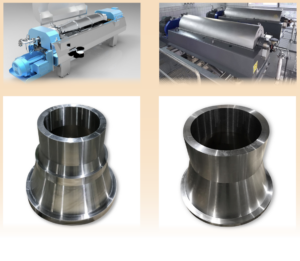
High-speed rotating equipment like centrifuges rely on a consistent density and shape for balance. Because centrifugal casting produces seamless, uniformly strong results, it’s a perfect process for this application.
Centrifugal castings keep their symmetrical shape, and the fine grain structure results in producing products like centrifuge bowls, conical sections, and scroll shafts.
Advantages: Can make quick, reliable solutions for centrifuges
Industry Applications: Oil & Gas, Water Processing, Food Separation, Liquid Clarification, Waste Processing, and more
An experienced foundry makes the difference
Though centrifugal casting has been proven to produce strong, reliable parts, the process is only as good as the foundry behind it. Forty-five years of experience means Spuncast metal foundry not only knows the best practices for centrifugal casting, but we also know a lot about meeting customer expectations.
We offer heat treatment, CNC machining, and metallurgical expertise in addition to making high-caliber stainless steel cylinders on time and at the best possible price. With over 200 alloys to choose from, we’ll help you find the best material properties that fit your application perfectly too.

